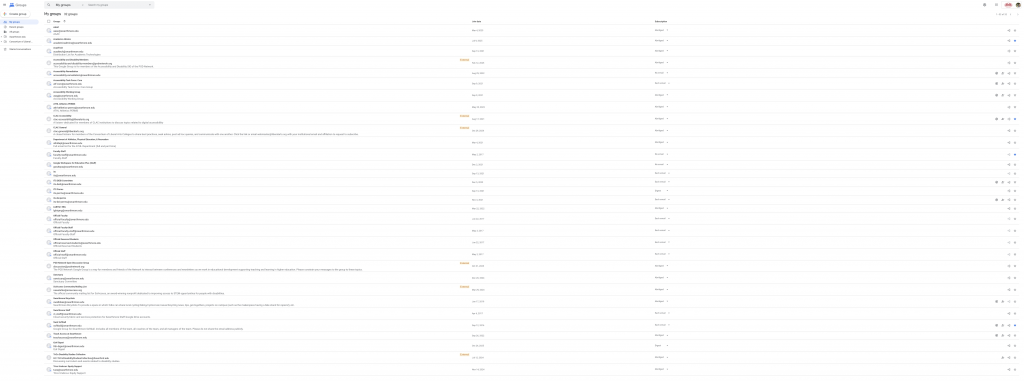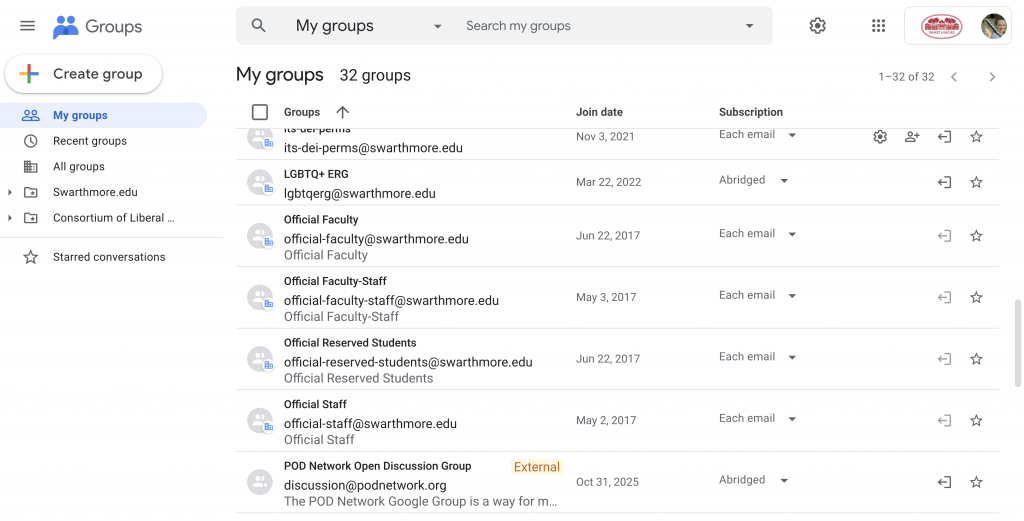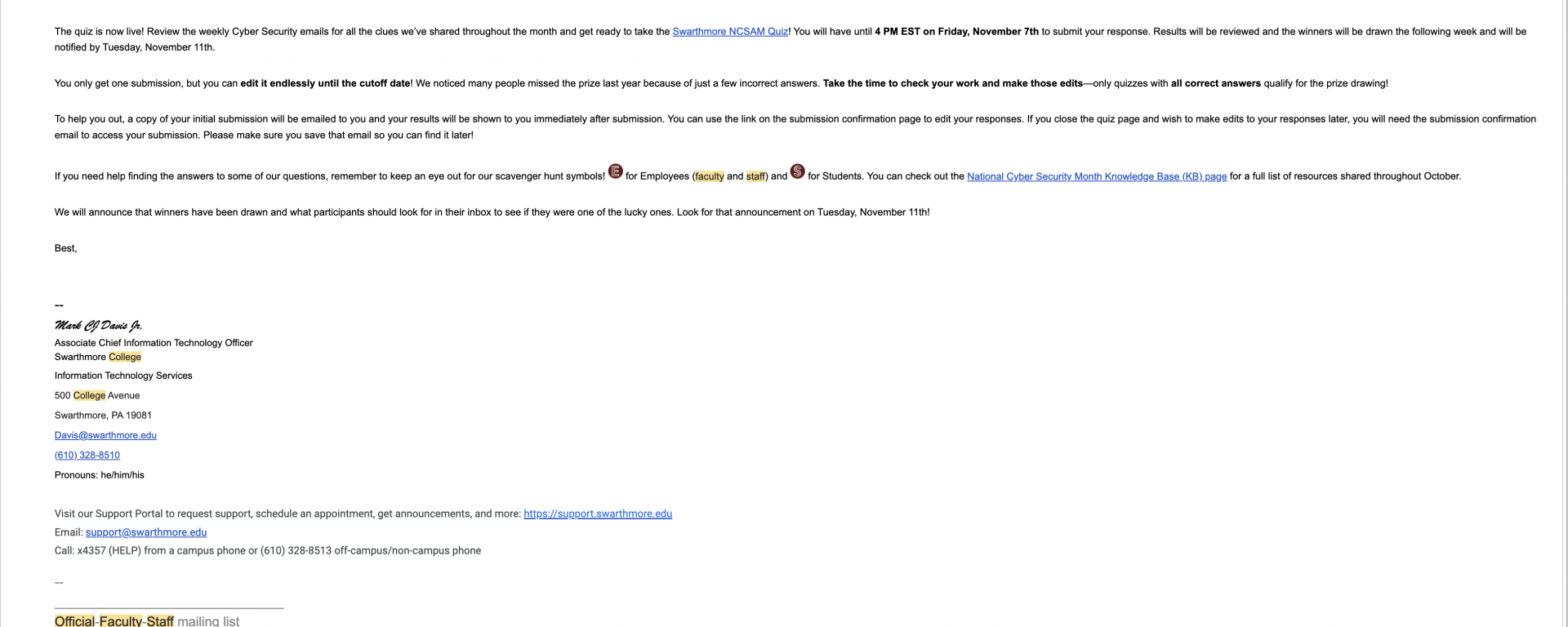Are you tired of email? Do you find yourself overwhelmed by the sheer volume of official messages? Navigating listservs at Swarthmore can often feel confusing.
Good news! Swarthmore’s Accessibility Working Group identified communication as one of our improvement goals for the year. In light of that, Liz Derickson and I met up to review subscription options in Google Groups—and we think we found the keys to email sanity.
As a member of a Google Group, you can choose to receive:
- No email;
- abridged email;
- digest email;
- or each email.
You control the subscription options in Google Groups for every Google Group you belong to. For instance, you might want to receive each email for timely and important announcements in moderated groups. However, for those groups you shouldn’t unsubscribe from, but where only one out of every five messages is relevant (and sometimes feels like spam!), you may want to select the abridged email option
No Email: The web-only option
No email means exactly that: you won’t receive any messages in your inbox.
Why would you choose this from the subscription options in Google Groups? Perhaps you already feel like a digital packrat, or maybe you just prefer a zero-inbox approach. While this option seems counter-intuitive for an actively subscribed list, it empowers you to monitor groups only occasionally through the web interface.
Here’s the catch: You must choose to regularly check the Google Groups web interface to read the messages. We haven’t identified a way for the system to notify you otherwise.

Patterns to the No Email option
- Rich Text Formatting (RTF), images, and hyperlinks remain intact.
- Attachments are present and available for you to download.
- You must actively check the Google Groups web interface.

Abridged Email: The snapshot
Abridged email sends an update when either a daily email is sent or 150 emails have arrived, whichever comes first. The specific arrival time seems to be a mystery, but my daily emails consistently hit my inbox at 8:05 pm!

Patterns to the Abridged Email option
This option strips away some formatting for a quick snapshot:
- You only see the first 4–5 lines when you view the email in your inbox.
- The system disables Rich Text Formatting.
- Attachments are removed.
- Images are removed; only the alt text remains.
- The system expands hyperlinks to show the full link text followed by the URL in angle brackets, i.e., Open Education Talks 2026<https://oetalks.opened.ca/>.
- You select the more… option in the email to view the entire content via the Google Groups web interface.
Digest Email: The daily briefing
Digest email sends a summary when either a daily email is sent or 25 emails have arrived, whichever comes first. At Swarthmore, we don’t often see 150 emails sent to any one Google Group per day, but during peak moments, a group might receive 25 or more messages in a single day. In that case, you might receive more than one digest that day.

Patterns to the Digest Email option
The Digest option summarizes the full messages:
- You see the entire email displayed.
- The system disables Rich Text Formatting.
- Attachments appear at the bottom of the entire message.
- You may find it difficult to distinguish which attachment belongs to which message.
- Images are removed; only the alt text remains.
- The system expands hyperlinks to show the full link text followed by the URL in angle brackets, i.e., Open Education Talks 2026<https://oetalks.opened.ca/>.
Each email: The full experience
Each email sends every single message exactly as it is posted.
Important Note: How this looks in your inbox depends entirely on your personal email client settings and reading habits. For example, some folks disable Rich Text Format (RTF) in their reader, so they would never receive RTF messages. Others choose to ignore images or must click to download them, which is a smart security practice, as Nick Hannon demonstrated in 2019 with his Reading your email the plain ol’ (safer) way blog post.
The patterns below assume you have RTF and images enabled in your email client.

Patterns to the Each Email option
- You see the entire email displayed.
- RTF remains intact.
- Attachments remain intact.
- You can download the attachments.
- Images remain intact.
- Hyperlinks remain intact.
Conclusions
The many subscription options in Google Groups that you can choose from means personal preference and workflow play a large role in your decision. Ultimately, the best way to receive Google Group emails depends on a combination of personal preference, workflow, and individual email client settings, such as whether rich text is enabled or if images automatically download.
While accessing messages directly via the web interface may be the “most” accessible option for some, it may not be the most user-friendly for everyone.
If you’re curious about how to make Google Groups work best for you, visit Manage your subscriptions & global settings | Google Support.
If you also want to improve the accessibility for the person who receives your emails, check out these valuable resources:
This article was conceptualized and initially written by the author, who then used Google Gemini to proofread, clarify, maintain a consistent tone, and otherwise make readability suggestions.

